 Last Updated: Dec 18, 2010 |
The Ancestors of א/B: |
 Last Updated: Dec 18, 2010 |
The Ancestors of א/B: |
|
Ancestor MSS: - א/B |
Originally the NT books were written separately, and circulated separately, and only later gathered into collections such as the Four Gospels, or the Letters of Paul, into one manuscript copy.
Rightly then has James Snapp Jr. insisted that the early textual history be analyzed separately, book by book:
"2. The text of the New Testament should be reconstructed in its component-parts: Gospels and Acts and Pauline Epistles and General Epistles and Revelation. Relationships shown by patterns of readings in one part should not be assumed to exist in the others."
Grouping and Organizing the Omissions of Aleph/B
If we take then the Gospel of Mark in hand, and list all the significant omissions by Aleph/B followed by the modern critical GNTs, we make some amazing and enlightening discoveries.
The omissions fall easily into three basic groups, with the missing letter counts being multiples of typical column widths for manuscripts from the late 2nd and early 3rd centuries. In other words, we can reconstruct what some of the ancestors of the common ancestor of Aleph/B looked like, to account for these strong correlations in line-length and column-width.
Since earlier ancestors (late 2nd century) had wider columns, the groups of omissions can be ordered chronologically and traced to the copyist who used such a manuscript as a master-copy.
Comparing the SBL-GNT with Hort
| Luke | |||||
|---|---|---|---|---|---|
| # | verse | chr | whole/half-verses omitted | WH | SBL |
| (01) | 1:28 | 22 | ευλογημενη συ εν γυναιξιν | Om | Om |
| (02) | 1:29 | 16 | ιδουσα διεταραχθη | Om | Om |
| (03) | 2:42 | 13 | εις ιεροσολυμα | Om | Om |
| (04) | 4:4 | 19 | αλλ επι παντι ρηματι θυ | Om | Om |
| (05) | 4:5 | 22 | ο διαβολος εις ορος υψηλον (h.t.) | Om | Om |
| (06) | 4:8 | 19 | υπαγε οπισω μου σατανα | Om | Om |
| (07) | 4:18 | 37 2x19 | ιασασθαι τους συντετρ ιμμενους την καρδιαν | Om | Om |
| (08) | 5:38 | 24 | και αμφοτεροι συντηρουνται (h.t.) | Om | Om |
| (09) | 6:45 | 23 | θησαυρου της καρδιας αυτου (h.t.) | Om | Om |
| (10) | 7:31 | 10 | ειπεν δε ο κς | Om | Om |
| (11) | 8:43 | 31 | ἰατροῖς προσαναλώσασα ὅλον τὸν βίον | Om | [in] |
| (12) | 8:45a | 13 | και οι μετ αυτου | Om | Om |
| (13) | 8:45b | 24 | και λεγεις τις ο αψαμενος μου | Om | Om |
| (14) | 8:48 | 6 | θαρσει (h.a.) | Om | Om |
| (15) | 8:54 | 19 | εκβαλων εξω παντας και | Om | Om |
| (16) | 9:10 | 11 | τοπον ερημον | Om | Om |
| (17) | 9:54 | 18 | ως και ηλιας εποιησεν | Om | Om |
| (18) | 9:55-6 | 96 2x48 4x24 (4x22) |
και ειπεν ουκ οιδατε οιου πνε υματος εστε υμεις ο γαρ υιος τ ου ανθρωπου ουκ ηλθεν ψυχας α νθρωπων απολεσαι αλλα σωσαι (h.t.) | Om | Om |
| (19) | 10:38 | 16 | εις τον οικον αυτης | Om | Om |
| (20) | 11:2 | 15 | ο εν τοις ουρανοις | Om | Om |
| (21) | 11:2 | 41 | γενηθητω το θελημα σου ως εν ουρανω και επι της γης | Om | Om |
| (22) | 11:4 | 26 2x13 | αλλα ρυσαι ημας απο του πονηρου | Om | Om |
| (23) | 11:11 | 26 2x13 | αρτον μη λιθον επιδωσει αυτω ει | Om | Om |
| (24) | 11:44 | 31 2x15 | γραμματεις και φαρισαιοι υποκριται | Om | Om |
| (25) | 11:54 | 21 | ινα κατηγορησωσιν αυτου (h.t.) | Om | Om |
| (26) | 12:39 | 16 | εγρηγορησεν αν και (h.t.) | -- | Om |
| (27) | 17:9 | 10 | αυτω ου δοκω (h.t.) | Om | Om |
| (28) | 17:24 | 14 | εν τη ημερα αυτου (h.t.) | Om | Om |
| (29) | 17:36 | 56 4x14 2x28 |
δυο εσονται εν τω αγρω ο εις παραλη φθησεται και ο ετ ερος αφεθησεται (h.t.) | Om | Om |
| (30) | 18:24 | 18 | περιλυπον γενομενον | Om | Om |
| (31) | 19:45 | 20 | εν αυτω και αγοραζοντας (h.t.) | Om | Om |
| (32) | 20:23 | 13 | τι με πειραζετε | Om | Om |
| (33) | 20:30 | 33 2x17 | την γυναικα και ουτο ς απεθανεν ατεκνος (h.t.) | Om | Om |
| (34) | 22:19b-20 | 152 8x19 | το υπερ υμων διδομενον τουτο ποιειτε εις την εμην αναμνησιν ωσαυτως και το ποτηριον μετα το δειπνησαι λεγων τουτο το ποτηριον η καινη διαθηκη εν τω αιματι μου το υπερ υμων εκχυνομενον | [[DB | [SB] |
| (35) | 22:31 | 14 | ειπεν δε ο κυριος | Om | Om |
| (36) | 22:43-4 | 141 7x20 | ωφθη δε αυτω αγγελος απ ουρανου ενισχυων αυτον και γενομενος εν αγωνια εκτενεστερον προσηυχετο εγενετο δε ο ιδρως αυτου ωσει θρομβοι αιματος καταβαινοντες επι την γην | [[DB | [ins] |
| (37) | 22:64 | 30 2x15 | αυτον ετυπτον αυτου το προσωπον και (h.t.) | Om | Om |
| (38) | 22:68 | 10 | η απολυσητε | Om | Om |
| (39) | 23:17 | 41 2x20 | αναγκην δε ειχεν απολυε ιν αυτοις κατα εορτην ενα (h.t.) | Om | Om |
| (40) | 23:23 | 15 | και των αρχιερεων (h.t.) | Om | Om |
| (41) | 23:38 | 48 2x24 | γραμμασιν ελληνικοις και ρω μαικοις και εβραικοις ουτος (h.t.)* | Om | Om |
| (42) | 24:1 | 17 | και τινες συν αυταις | Om | Om |
| (43) | 24:12 | ο δε πετρος αναστας εδραμεν επι το μνημειον και παρακυψας βλεπει τα οθονια κειμενα μονα και απηλθεν προς εαυτον θαυμαζων το γεγονος | [[DB | [ins] | |
| (44) | 24:36 | 24 2x12 | και λεγει αυτοις ειρηνη υμιν | [[DB | Om |
| (45) | 24:40 | 49 2x24 |
και τουτο ειπων επεδειξεν αυ τοις τας χειρας και τους ποδας | [[DB | [SB] |
| (46) | 24:42 | 21 | και απο μελισσιου κηριου (h.t.) | Om | Om |
| (47) | 24:46 | 12 | και ουτως εδει | Om | Om |
| (48) | 24:51 | 25 | και ανεφερετο εις τον ουρανον (h.t.) | [[DB | [SB] |
| (49) | 24:52 | 19 | προσκυνήσαντες αὐτὸν (h.t.) | [[DB | [SB] |
Taking the convenient list of Lukan omissions from above in hand, one immediately notices that 3 out of 4 of the largest chunks of text break into lines with 22 characters per line. This is not likely to be a mere coincidence. It is further corroborated by other shorter omissions, also breaking down into lines of 22 characters.
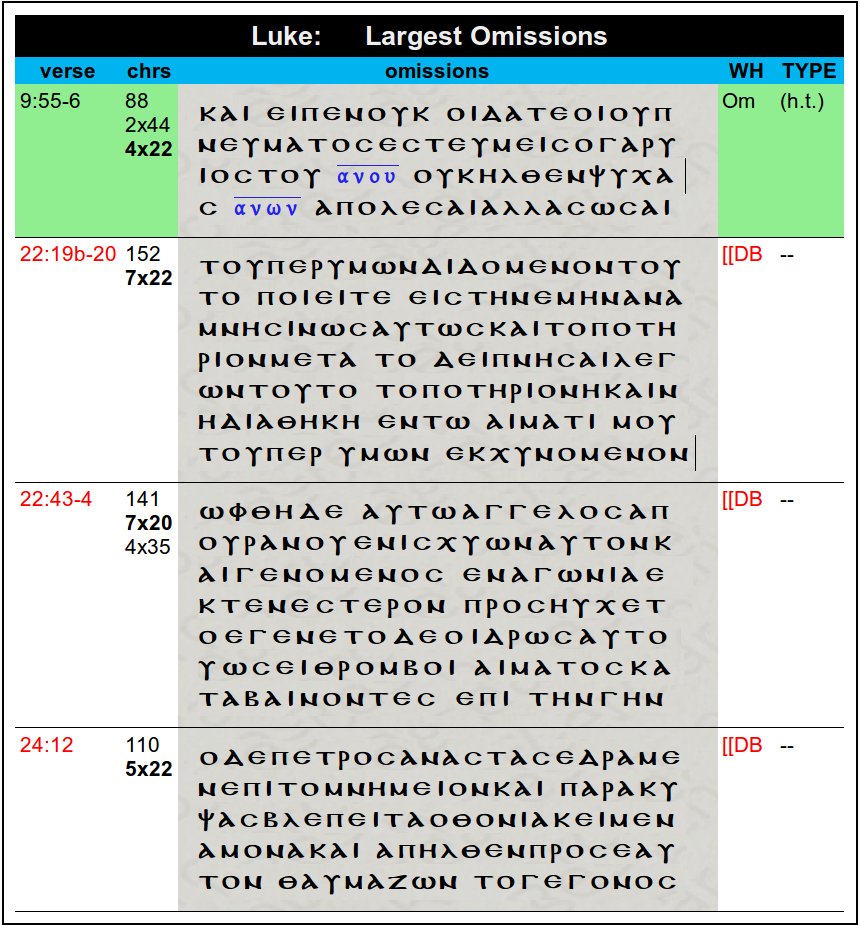
The following group, which we have labeled "Ancestor 1", conveniently groups line-lengths of 20 - 24 together. Although the 2nd half-chart may belong to a different (later) exemplar, the wider format is variable enough that all the omissions could have been generated from one master-copy.
The yellow coding indicates other possible placements for individual variants. Relatively few omissions would be from the older layers, especially obvious cases of homoeoteleuton, because some would be caught in subsequent generational copying and proofreading. The omissions without homoeoteleuton features would be most difficult for correctors to find and properly identify. We should not then be surprised that the early candidates would be somewhat fewer in number.
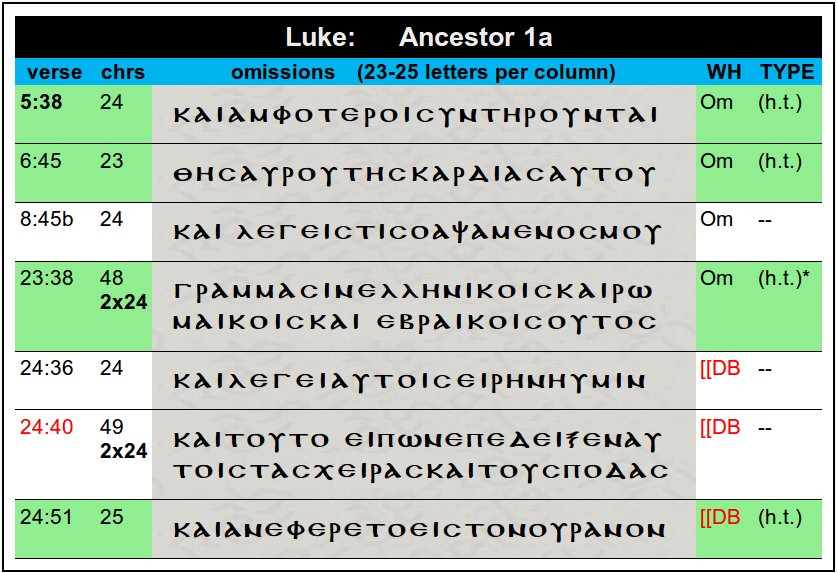
Because of variable line lengths in wider manuscripts, its a toss-up whether the "1b" list and "1c" lists below belong to separate exemplars or to a single bad copy from one exemplar.
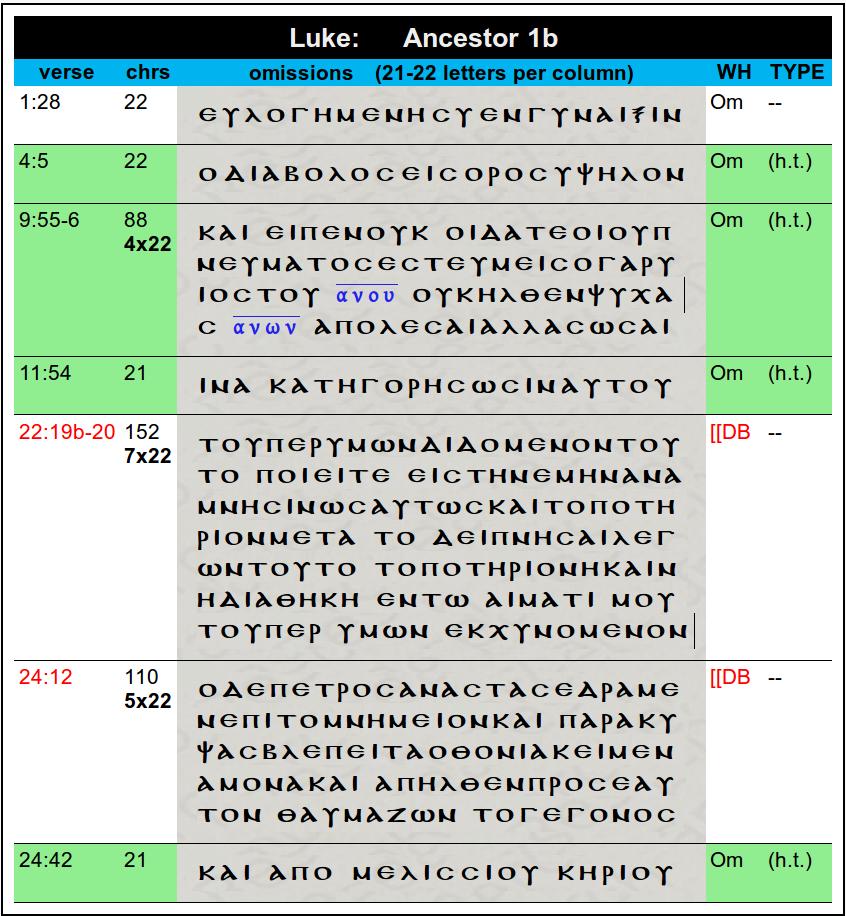
Ancestor 1c has moderately more credibility than 1b, because codices like Codex Alexandrinus were 20 letters wide and very strictly done so that little line-length variation is found in this style of manuscript.
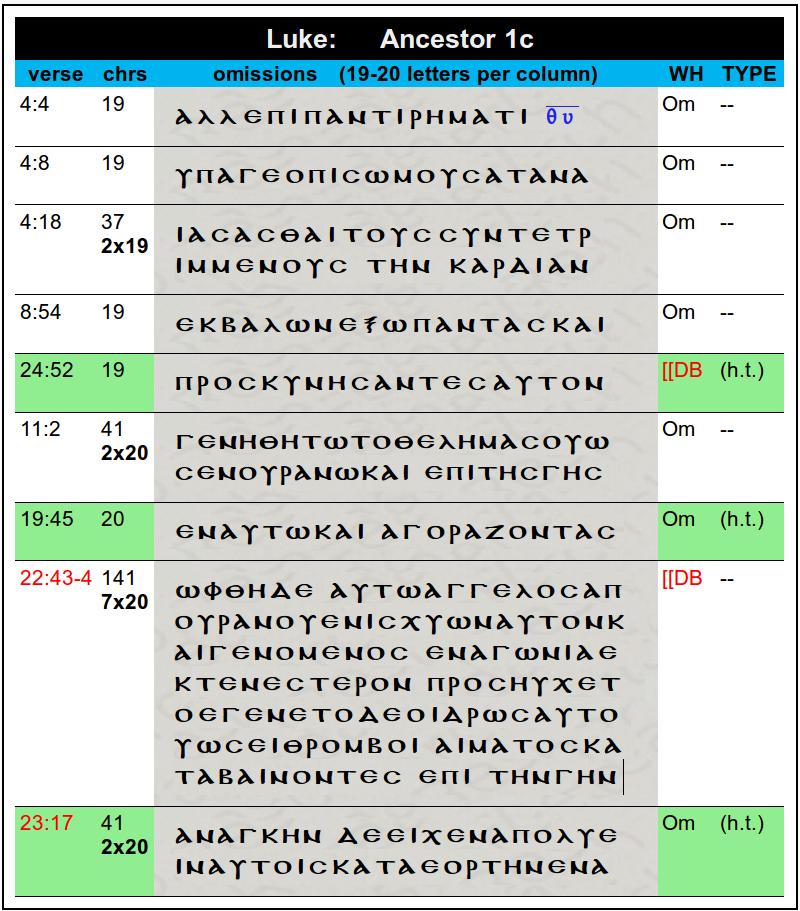
Candidates for Ancestor 2 are more certain, and hence more attractive, by the nature of the numbers, which offer less alternative line-lengths to choose from.
The Green color-coding indicates homoeoteleuton. Although the list is shorter, the existance of the exemplar is a little more certain:

Another very common format, approx. 15 lpc. The lack of theological, historical, or linguistic reasons for the omissions/additions also corroborates an accidental cause.
This column width is relatively narrow, and so these omissions arose later in the copy-stream, when narrower columns were selected for the very purpose of cutting down on accidental copy-errors, i.e, 3rd century. It reflects the style of Codex Sinaiticus in terms of page format. Earlier MSS had wider columns.
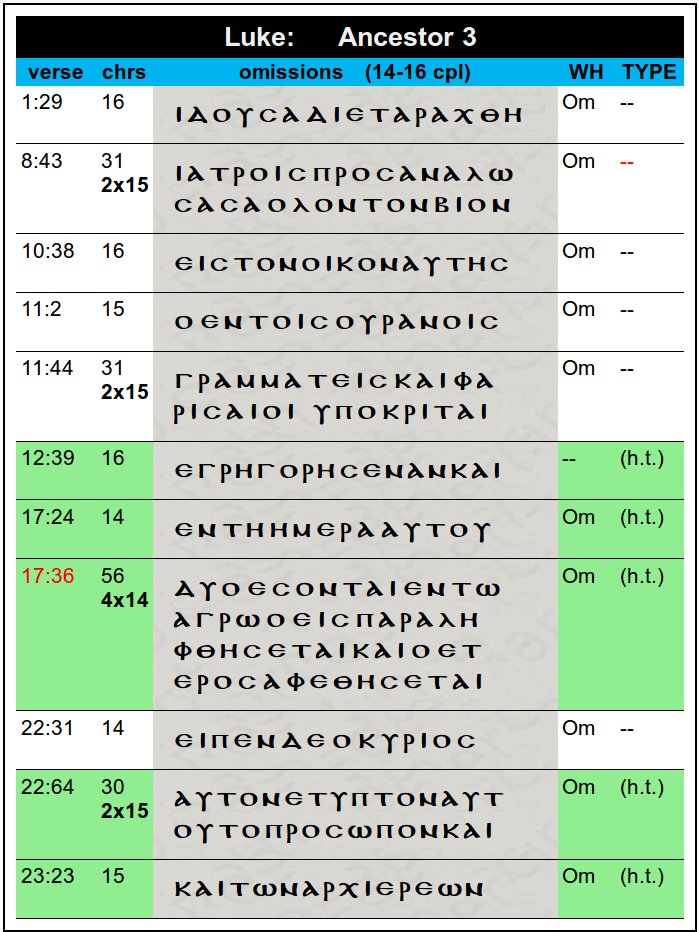 -->
-->
One or two of these omissions could have been generated in an older, wider-column exemplar, much earlier in the transmission-stream, but more manuscripts would have been manufactured in the narrower format, as copying spread rapidly in the later centuries. There seems to be plenty of possible omissions from an exemplar of this width.
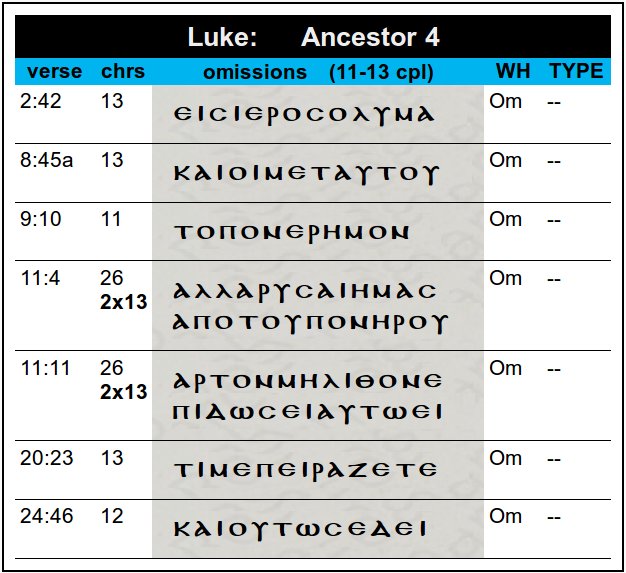
Manuscripts with columns narrower than 10 letters would be very rare, if they existed at all. Ancestor 6, then, really represents the 'left-overs'. Smaller omissions that are more likely to have been generated along the same line, or in the process of memorizing a long clause. They could have taken place at any time or generation of copy, and must be left as 'floating omissions'.
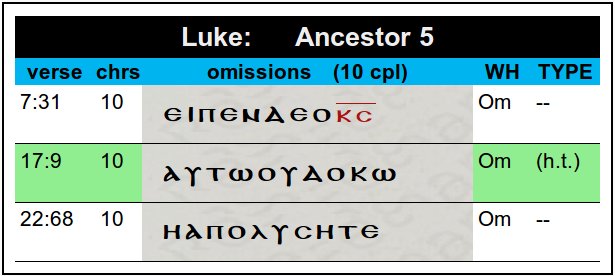
Manuscripts with columns narrower than 10 letters would be very rare, if they existed at all. This, then, really represents the 'left-overs'. Smaller omissions that are more likely to have been generated along the same line, or in the process of memorizing a long clause. They could have taken place at any time or generation of copy, and must be left as 'floating omissions'.
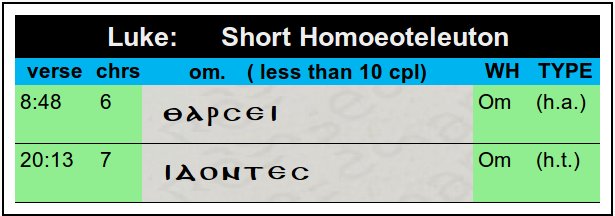
What this evidence shows, in comparison with what we found regarding Matthew, is that Luke has suffered at least "4 bad generations" of copying, whereas Matthew has only seemed to have suffered about 3 or 4.
This is precisely what we should expect, since Luke is a much older document, and would have been subjected to more generations of corruption than Matthew. What we see then, is different lines of bad copying converging in the 'ancestor' of Aleph/B. Originally, these gospels would have been copied as separate books, but were then brought together in the 2nd century.
The Omissions have been examined elsewhere (see our Homoioteleuton Blogsite for reconstructed layouts and textual evidences for these Variation Units.).
Our concern at the moment here is to show that:
a) Hort was wrong about the 'purity' of Aleph/B.
b) The textual history of the Aleph/B line of transmission can be reconstructed very adequately, with a proper consideration of all the available evidence and appropriate technique.
c) The Omissions of Aleph/B should never be adopted into the Christian NT text, except in certain extremely unusual circumstances.
This is an isolated, unreliable and infrequently corrected line of transmission, and all but useless for textual correction.
mr.scrivener
|
Ancestor 1a: |
This good copy had about 23-25 chars per line, and contained most of the text lost to Aleph/B's ancestor. |
|
|
At some point, a copyist used Ancestor 1a as a master-copy, but lost Luke 5:38, 8:45b, 23:38, 24:36, 24:40, 24:51 and probably Luke 6:45 . A copy of this then became... |
|
Ancestor 1b: |
At least one copy was made at 21-22 chars per line. But, it was not well corrected. |
|
|
A copy of Ancestor 1b was used as a master, but text was lost again: Luke 1:28, 4:5, 9:55-6, 11:54, 22:19b-20, 24:12, 24:42 suffered eye-skips, which again escaped proof-readers. |
|
Ancestor 1c: |
At some point a copy was made at 19-20 cpl, becoming Ancestor 1c. |
|
|
A copy of Ancestor 1c was used as a master, but this bad copy lost text again: Text from Luke 4:4, 4:8, 4:18, 8:54, 24:52, 11:2, 19:45, 22:43-4, 23:17 was lost. |
|
Ancestor 2: |
At least one copy of this text was made 17-18 chars per line. But, it was not well corrected. |
|
|
A copy of Ancestor 2 was used as a master, but four more spots took damage: Luke 9:54, 18:24, 20:30, 24:1 all suffered eye-skips, unnoticed. |
|
Ancestor 3: |
As errors accumulate in this isolated line, a 14-16 cpl copy is made. A width meant to minimize copy errors. |
|
|
But the new format adds yet more errors; Possibly overconfidence led to less checking. Luke 1:29, 8:43, 10:38, 11:2, 11:44, 12:39, 17:24, 17:36, 22:31, 22:64, 23:23 suffered losses. |
|
Ancestor 4: |
A new even narrower format is chosen, in the style of Codex Sinaiticus. |
|
|
But previous accumulated errors are not fixed. Error checking appears limited to the immediate master-copy. More errors accumulate; Luke 2:42, 8:45a, 9:10, 11:4, 11:11, 20:23, 24:46 are the latest victims. |
|
Ancestor 5: |
An even narrower format is used. The Four Gospels were probably combined into a single MS at this point. |
|
|
Accumulated errors go unnoticed. Another generation results in a few more h.t.: Luke 7:31, 17:9, 11:68 fall by the wayside. |
|
Proto-Aleph/B: |
This master-copy is the nearest ancestor of Aleph and B. |
|
|
A copy of this MS probably resided in the scriptorium at Caesarea where א & B were made. One or two shared readings might be coincidences, but most of those listed will come from the immediate ancestor of Aleph/B. Short skips at Luke 7:31, 17:9, 22:68 are also lost at some unknown point. |
|
א B |
The dying and deficient Alexandrian line now spreads apart, leaving a few divergent copies. Erroneously approved by ecclesiastics, it was used briefly in Caesarea, but shortly thereafter abandoned for better MSS. |
